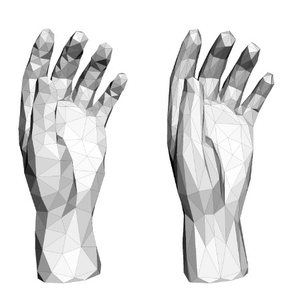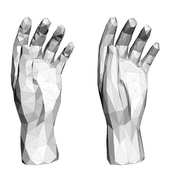Information
- Publication Type: Bachelor Thesis
- Workgroup(s)/Project(s):
- Date: October 2014
- Date (Start): 21. October 2013
- Date (End): 28. February 2014
- Matrikelnummer: 1026408
- First Supervisor: Stefan Ohrhallinger
- Keywords: sampling, mesh, modeling
Abstract
Currently, in modeling there is a lot of manual work involved in reducing the number of vertices/triangles in geometry to balance efficiency vs. accuracy of the intended shape. Our aim is to automatically find an optimum for that, by resampling an input model, e.g. created by an artist.We need to process the geometry of a model discretely (as in points/triangles instead of a continuous boundary) for rendering it on the screen, animation or collision detection. Such models can be given by an explicit boundary (spline, triangle mesh) or implicitly by a signed distance function, e.g. defined at octree nodes, from 3D scanner data approximated by implicit surface reconstruction methods, such as Poisson.
We want to represent this boundary by as few points as possible while losing only as much detail as determined by a user-controlled parameter. We use a medial condition which adapts to local features of arbitrary size. This also permits us to drop connectivity (edges, triangles), so that the output becomes a point cloud. The parameter can control either the maximum deviation of the generated boundary to the input, or a point budget.
Additional Files and Images
Weblinks
No further information available.BibTeX
@bachelorsthesis{geyer_lukas-2014-bat,
title = "Volume-aware Mesh Resampling",
author = "Lukas Geyer",
year = "2014",
abstract = "Currently, in modeling there is a lot of manual work
involved in reducing the number of vertices/triangles in
geometry to balance efficiency vs. accuracy of the intended
shape. Our aim is to automatically find an optimum for that,
by resampling an input model, e.g. created by an artist. We
need to process the geometry of a model discretely (as in
points/triangles instead of a continuous boundary) for
rendering it on the screen, animation or collision
detection. Such models can be given by an explicit boundary
(spline, triangle mesh) or implicitly by a signed distance
function, e.g. defined at octree nodes, from 3D scanner data
approximated by implicit surface reconstruction methods,
such as Poisson. We want to represent this boundary by as
few points as possible while losing only as much detail as
determined by a user-controlled parameter. We use a medial
condition which adapts to local features of arbitrary size.
This also permits us to drop connectivity (edges,
triangles), so that the output becomes a point cloud. The
parameter can control either the maximum deviation of the
generated boundary to the input, or a point budget. ",
month = oct,
address = "Favoritenstrasse 9-11/E193-02, A-1040 Vienna, Austria",
school = "Institute of Computer Graphics and Algorithms, Vienna
University of Technology ",
keywords = "sampling, mesh, modeling",
URL = "https://www.cg.tuwien.ac.at/research/publications/2014/geyer_lukas-2014-bat/",
}

 thesis
thesis

